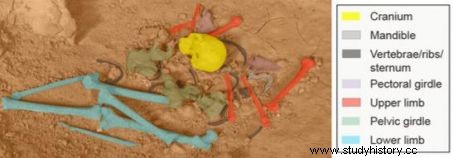A remarkable cave, located in the Dordogne, lifts the veil on ritual practices and funerary traditions dating back 30,000 years.

The decorated cave of Cussac (Dordogne) and its engraved bestiary.
The case is absolutely exceptional! The decorated cave of Cussac, in the Dordogne, one of the most spectacular engraved sanctuaries of all European Paleolithic art, conceals another treasure. A set of burials preserved in the depths of the cavity such as have never been discovered in any other decorated site. The results of the analysis of six "human deposits" - unburied bones - 25,000 to 35,000 years old - have indeed been published in an article in the journal Proceedings of the National Academy of Sciences (PNAS). Their discovery dates back to 2000 when this deposit was unearthed in the commune of Buisson-de-Cadoin, in the Vézère valley. They rested in three bear dens located in the heart of the imposing cavity. And if their study took so long, it is because of the difficulty encountered by researchers in working in this cave decorated with nearly 800 masterpieces of parietal art (horses, bison, mammoths, rhinos, ibex, birds – but also exceptional stylized Venuses-), all scattered over 1.6 km in length.
"Touch only with the eyes"
Too full of carbon dioxide, the air is indeed unbreathable. The teams authorized to deploy there for ten years can only do so for a few days a year, only in winter, each visit not to exceed two hours. Intervening there also means "touching only with the eyes". Indeed, as with the Chauvet cave (Ardèche) and so many other prehistoric sites today, everything is done to preserve these environments as they were left by prehistoric hunters. Thus, it is impossible for researchers to circulate other than by following marked routes intended to preserve the silty soils covered with calcite. Even less, to touch the walls where the achievements of the groups of the Gravettian culture (named after the site of Gravette, in Dordogne) to which all these works are linked. Protective suits and sterilized boots are mandatory, as no microorganism should enter this high place of prehistory.
 Images taken inside the cave of Cussac (Dordogne) showing rock art, researchers and ancient human remains. Credits:N.Aujoulat / National Center for Prehistory /Ministry of Culture/University of Bordeaux/PCR Cussac
Images taken inside the cave of Cussac (Dordogne) showing rock art, researchers and ancient human remains. Credits:N.Aujoulat / National Center for Prehistory /Ministry of Culture/University of Bordeaux/PCR Cussac
In fact, only new technologies and 3D imagery are used to study the works but also the bones. Photogrammetric data with sub-millimeter precision. This is how, - at a social distance -, as we would say today, the organic remains preserved in the old bear caves were analyzed, used by the occupants of the cave long after these last plantigrades had disappeared. Tiny samples were nevertheless taken from the bone remains for the purposes of dating and paleogenetic analyses. “We were able to determine that these human remains belonged to six individuals – one adolescent and five adult males. All arranged in a particular way. In some cases, the bones of several people were intermingled “, explains the prehistorian Jacques Jaubert, of the Pacea Laboratory * of the University of Bordeaux-1, who directs this work.
 Digitized skeletal elements from one of the bear dens (Locus 2). Credits:PACEA
Digitized skeletal elements from one of the bear dens (Locus 2). Credits:PACEA
All were covered with ocher pigments, reflecting complex symbolic behaviors. “These skeletal elements were intentionally deposited in two nearby sectors located very deep inside the cave. Most are skullless, although a few teeth have been found. Only one individual is complete “, specifies the specialist, joined by Sciences et Avenir. So much information that reveals manipulations of corpses, post-mortem treatments of bones, reflections of the beliefs and funerary practices of the populations of the Gravettian, the second great culture of the European Upper Palaeolithic. No infants or children were included. "These results provide a window into the social diversity and complex interactions between the living and the dead within these hunter-gatherer populations “says Jacques Jaubert. To date, the Gravettian burials previously encountered – like the Abri Pataud, or the Cro-Magnon site – have been in open air sites, rock shelters or at the entrance to caves. . Never in the depths of a cave. Moreover, a site where the dead and engraved animals are associated.
Pacea* Laboratory, From Prehistory to the Present:Culture, Environment and Anthropology.
